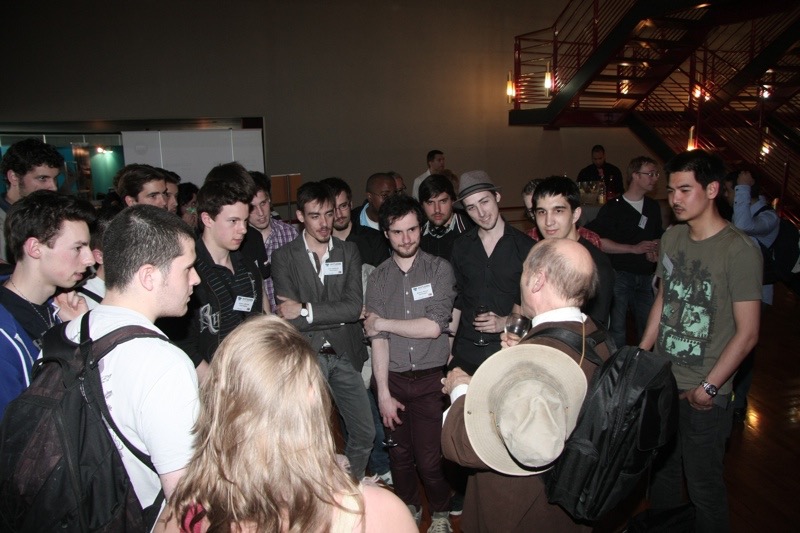June 4th - 10th, 2013
I traveled to Valenciennes to speak at the e-viruoses conference; this was about serious games. I lectured on the importance of developing algorithmic literacy. I also served as jury president for the juries that judged the awards. It was a busy time; I can’t recall any time during which I kicked back and caught my breath. There were a ton of programs to consider, covering a broad range of ideas – so many that I have difficulty remembering them all. Instead of covering them all, I’ll merely compile a collection of random recollections.
The most visually impressive piece was something with the laudable goal of helping pregnant women prepare for childbirth. It addressed such issues as when to wait versus when to go to the hospital and what would happen at the hospital. It included a magnificent animation showing how the baby emerges from the body, twisting as it goes. While it was a beautiful piece, it really wasn’t much in the way of software; the user didn’t do much. Crawford’s First Law pretty much blows it out of consideration. A shame.
There was also a helicopter simulator meant to help infuse safety habits into helicopter pilots. Its main function was to demonstrate that some situations require the pilot to abort the mission – a useful function. But I had the bad feeling that most of the appeal of the game was as a traditional flight simulator.
The best design concept, in my opinion, was meant to demonstrate why online privacy is important. This was accomplished by a game in which the player is a data seller, accumulating vast amounts of data about people and selling it to any buyer. By acquiring truly personal data (such as medical information) about people from questionable or illegal sources, and combining it with otherwise innocuous data, the player can create valuable datasets worth a lot of information. There’s a lot of synergy in information, so the value of your data grows exponentially, encouraging more aggressive efforts to collect data. All in all, an excellent way to make youngsters realize the importance of protecting their privacy.
There were of course plenty of dumb ideas with beautiful graphics and stupid gameplay. I’ll single out one piece for shaming: a bit on Versailles. This program exemplifies the brute-force combination of game with content. They couldn’t think up anything interactive about Versailles per se, so they just crammed random bits together. For example, they had a kind of Rubik’s Cube game in which virtual buildings composed of three rotating layers had to be rearranged in order to find the harmonious combination. Whoop-de-doo.
I very much liked a piece for a museum intended to encourage students to look around the entire museum. The design is difficult to explain without the component pieces; basically, it’s a combination of a social game with a trading game. The players are issued special cell phones that can read special posters placed next to some of the exhibits. The player touches the cell phone to the poster and so ‘acquires’ the exhibit. The player’s goal is to acquire a complete set of related exhibits, but this would require a great deal of traipsing through the museum; swapping exhibits with other players speeds the process. What impressed me about the design is its extensibility. The jury members saw lots of ways that it could be expanded/extended. A truly good design has lots of malleability.
Speaking of design, we encountered a brilliant example of truly bad design on attempting to exit the parking garage. To exit, we had to pay through the parking ticket machine. The driver of the car hopped out to pay the fee, but couldn’t seem to figure out how to get the machine to accept payment. So one of the passengers hopped out to help. Two minutes later, a second passenger joined in. Then a passerby joined the fray:

When Microsoft designs a parking ticket dispenser
We eventually got out, but I don’t know how. I think they had to hack in through the email port.
I had some wonderful discussions with students. They are eager to learn and pummeled me with questions. They also asked for me to sign copies of my book, give autographs, take pictures with them. It was frustrating trying to impart so much to them in so little time. My best moment came when I emphasized to them the importance of integrating all the persons they are. I picked one young woman out of the group and said, “You are the little girl you were, playing with dolls. You are the old woman lying in bed, dying, contemplating a long life. You are the teenager you were when first you fell in love. You are the mother you will be, coping with teenage children. You are all these things. Hold onto all of them, keep them together, unify them into a single person, and you cannot sin. If you wish to design games, you must never, ever lose touch with who you were when you were a child.” At this point I reached into my backpack and pulled out Frogger-Rogger. “I keep Frogger with me to help remind me of what I was like as a child. I talk to Frogger; I take him to bed with me at night. In your rush to grow more mature, do not lose what you were when you were less mature.”
That was a good moment.

Students confront Crawford
It’s truly strange that, in the USA I’m regarded as a dried-up old fossil, obsolete and useless, while in Europe I am treated as something of a sage. My guess is that it all boils down to my emphasis on art, which earns me contempt in American society and admiration in European society. In ten years, the Games For Change festival in New York has never invited me to speak, and has repeatedly turned down my proposals; it’s pretty clear that they don’t think much of me. But in France they gave me a prominent position in their conference. Go figure.

Lecturing
I had one other good moment. At the end of the conference, they staged a panel discussion in which nine young people presented their reactions to the conference, and two old fogeys (myself and another fellow) reacted to the students’ reactions. In the Q&A session afterwards, a teacher questioned the whole educational games concept. If we inundate students with games, won’t the novelty value wear off and won’t students be just as bored with games as they are with books? I replied with a simple question: “Suppose that we require all college students to take a course called Sex Orgy 101. Do you think that college students will lose interest in sex?”
A few minutes later I expanded on the concept by referencing Alvin Toffler’s book Future Shock. Society is changing faster and faster, and the expertise we have today will be obsolete in fewer and fewer years. I myself have had to learn and unlearn quite a few technologies, and it will be even harder for students today. We will need to greatly expand our educational system to enable people to keep up with expanding information. In classical times, people learned by direct interaction with teachers, but that system was limited in the number of students and the amount of information it could communicate. The printing press made it possible to provide students with books, vastly expanding our educational capacity. Now computer simulation games permit a new jump. Will it be enough? Malthus predicted that population growth would outstrip food supply, but agricultural production turned out to stay just one jump ahead of population. Will education manage the same trick? I don’t know, but educational software is our best bet.
But this will not happen until we expand algorithmic literacy, just as books had no value until we expanded literacy.
Many other experiences spangled my time in Valenciennes, but I have already gone too long on them.
